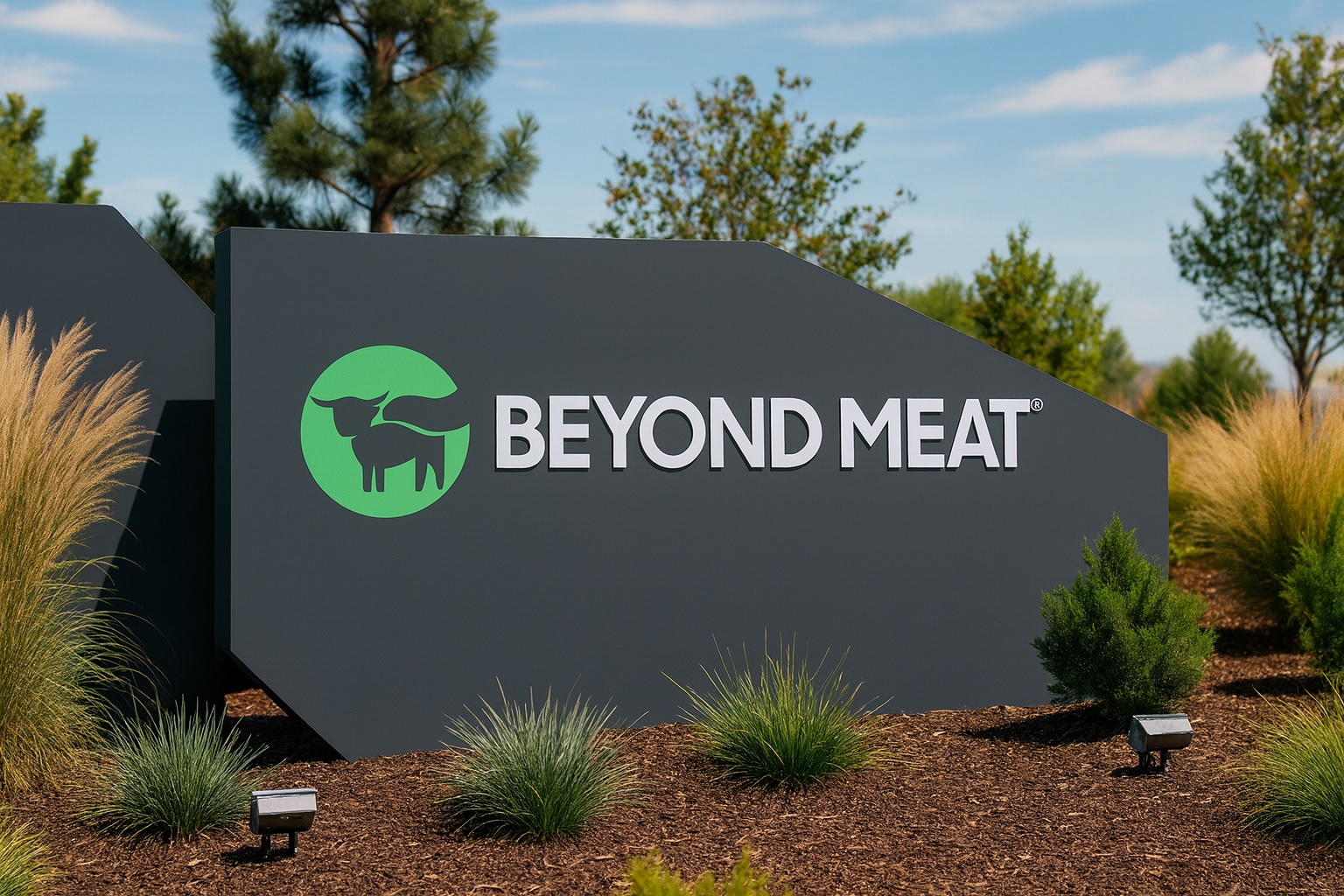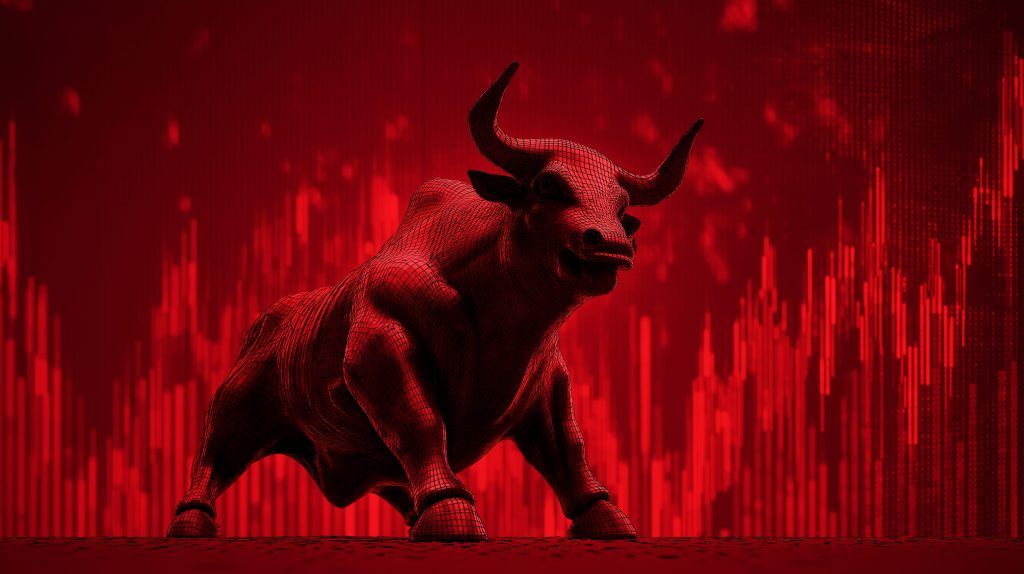- Whiplash week: Beyond Meat’s stock (NASDAQ: BYND) went on a roller coaster in late October. After crashing under $1 to all-time lows mid-month, BYND then skyrocketed nearly 600% in a frenzied short-squeeze rally – from about $0.50 on Oct. 16 to roughly $3.62 by Oct. 21 [1] [2]. By Friday Oct. 24, it had pulled back to around $2.19 per share, still massively up from its lows but far below its meme-fueled peak.
- Dilution disaster: A debt-for-equity swap completed in mid-October helped Beyond Meat retire ~$900 million in debt but at a steep cost to shareholders [3]. The deal issued about 316 million new shares – quadrupling the share count overnight – and sent BYND plummeting ~60% in one day as investors panicked over the “huge new share flood” hitting the market [4] [5]. The stock traded under $1 for the first time ever on Oct. 13–17, erasing 97% of its value from its 2019 IPO-era peak [6].
- Meme-stock frenzy: Heavily shorted and left for dead, BYND then became a meme stock target. With short interest reportedly over 60% of its float, retail traders on Reddit and social media piled in, igniting a furious short-covering rally [7]. BYND’s trading volume exploded into the billions of shares as the price leapt 128% in one session (Oct. 20) and another 146% the next day after a bullish Walmart partnership announcement [8]. At one point Oct. 22, shares hit ~$5–6 intraday before gravity returned [9].
- Fundamentals under strain: Beyond Meat’s core business remains weak. The company’s sales have been shrinking and losses mounting for years. Q2 2025 revenue was just $75 million (–19.6% year-on-year) with a net loss of $33 million [10]. Preliminary Q3 results indicate ~$70 million revenue (down ~13%) and razor-thin gross margins (~10–13%) [11]. Annual revenues have slid from $465M in 2021 to ~$326M in 2024 [12], and BYND has never turned an annual profit [13]. The company has burned close to $1 billion since 2021, while its cash dwindles (~$117M mid-2025) and debt remains high [14].
- Analysts and outlook: Wall Street is largely bearish on Beyond Meat. Most analysts rate BYND a sell, with median 12-month price targets in the ~$2 range [15]. Mizuho Securities, for example, just cut its target from $2 to $1.50 and reiterated an “Underperform” rating amid the dilution [16]. TD Cowen went even lower to $0.80, warning of an “existential threat” if the company can’t reverse course [17] [18]. While the debt restructuring eased bankruptcy fears for now, experts say Beyond Meat’s survival hinges on a drastic turnaround in demand and cash flow.
Stock Collapse and Meme-Fueled Surge 🚀
Beyond Meat’s stock has just lived through a stunning boom-and-bust within days. In mid-October, BYND imploded into penny-stock territory following a controversial debt restructuring. On Oct. 13, shares opened around $0.84 – a 56% plunge intraday – after news that Beyond Meat had massively diluted shareholders to avoid default [19] [20]. By that week’s end (Oct. 17), BYND was clinging to roughly $0.65 per share [21]. It was a remarkable fall from grace: the stock is down ~97% from its euphoric 2019 highs (when it traded at $235) [22]. This collapse left Beyond Meat valued at barely $200 million, a far cry from its ~$14 billion market cap at the peak [23] [24].
Then came an equally dramatic upswing. Beginning around Oct. 20, Beyond Meat became the latest protagonist of a meme-stock short squeeze. With so many traders betting against BYND, even a small spark ignited a huge rally. That spark arrived as retail investors on forums like Reddit’s WallStreetBets noticed BYND’s extreme decline and towering short interest. “Loss-making, heavily shorted, meme-able ticker and easy to understand – the classic meme cocktail,” one analyst quipped of the situation [25]. As buying momentum snowballed, short sellers rushed to cover positions, sending the stock skyrocketing. BYND surged over 120% on Monday, Oct. 20, then another 146% on Tuesday [26]. By Oct. 21, shares hit roughly $3.62 at close (having been ~$0.50 just days prior) [27]. In intraday trading on Oct. 22, the stock briefly touched the $5–6 range amid a frenzy of speculative buying [28].
Online hype played a major role in the burst. BYND suddenly trended among top mentions on social platforms, and one meme-stock ETF even added Beyond Meat as a holding with a >10% weight [29]. According to Reuters, retail traders bought nearly $35 million worth of Beyond Meat shares on Oct. 21 alone – a record one-day inflow [30]. “Whether this goes to infinity and BYND or just serves up another slice of fake-meat humble pie, retail is clearly having meme-fun,” joked Ivan Cosovic of data group Breakout Point [31]. However, professional traders warned that such explosive gains were untethered from reality and could evaporate just as fast. Indeed, by the end of that week the stock had given back much of its meme rally: BYND closed at $3.58 on Oct. 22, then $2.84 on Oct. 23, and ended Friday Oct. 24 at $2.19 [32] – still triple the 50-cent lows but well off the highs. The “dead cat bounce” appears to have been short-lived as fundamentals reasserted themselves.
Debt Restructuring Sparks Panic
The chaos began with Beyond Meat’s aggressive attempt to fix its debt-laden balance sheet. Facing a $1.15 billion zero-coupon convertible note due in 2027, the company struck a deal in October to swap debt for equity. Bondholders tendered an astonishing 96.9% of those notes in the exchange [33] [34]. In an early settlement on Oct. 15, Beyond Meat issued about $208.7 million of new 7% convertible notes (due 2030) plus 316,150,176 new shares to retiring bondholders [35] [36]. This move slashed the company’s debt to roughly $250 million from over $1.1 billion [37], substantially easing near-term default risk. However, it came at the cost of massive dilution: Before the swap, Beyond Meat had only ~77 million shares outstanding – now its share count will balloon to nearly 393 million once all the new stock is freely trading [38]. One analyst called it “a huge dilution bomb,” noting existing shareholders suddenly own a much smaller slice of the pie [39].
Not surprisingly, BYND’s price collapsed on the dilution news. As the deal closed and a lock-up on the new shares expired Oct. 16, investors braced for a “tsunami” of stock hitting the market [40]. The selling wave crushed Beyond Meat’s stock well under the $1 mark. BYND hovered in the $0.50–$0.80 range for several days – officially a penny stock. It’s a dramatic reversal for a company that went public at $25 in 2019 and once traded above $200. The dilution and cratering share price also triggered leadership tremors: founder and CEO Ethan Brown resigned from the board of directors amid the crisis (though he remains CEO), and at least two other directors exited, with a bondholder representative added to the board [41]. The governance shake-up underscored how dire the situation had become. Wall Street analysts slammed the development; many already saw Beyond Meat in a “death spiral” of declining sales and high debt [42], and the dilutive swap only reinforced bearish sentiment [43]. TD Cowen analysts warned of an “existential threat” to the company unless it can dramatically reinvent itself after this near wipe-out [44].
Walmart Deal and Meme Rally Catalyst
Ironically, the fundamental news that coincided with Beyond Meat’s meme rally was positive – just not enough to justify the scale of the stock move. On Oct. 21, the company announced a major distribution deal with Walmart, expanding Beyond Meat’s presence to over 2,000 Walmart stores [45] [46]. As part of the rollout, Walmart will carry new value packs of the Beyond Burger (a 6-pack of plant-based patties) as well as Beyond’s plant-based chicken tenders and a Korean BBQ-style beef product in its frozen aisles [47]. CEO Ethan Brown hailed the partnership, saying it “provides more consumers with access to Beyond’s clean and nutritious plant protein products” – and notably at a lower price point per patty with the new bulk pack [48] [49]. This news sent BYND stock soaring another 146% on Oct. 21, adding fuel to the retail trading frenzy [50].
To be clear, nothing about the Walmart deal or any other fundamental development justified a 5x–6x jump in Beyond Meat’s market value in days. Analysts note there were no surprising earnings or breakthrough product reveals driving the spike – it was a classic momentum play. Bloomberg and Reuters both reported that no fresh SEC filings or material corporate announcements explained the rally; it was purely a speculative surge driven by trader “fear of missing out” and a massive short squeeze [51]. As one analyst put it, the move was “about flow and attention, not a sudden turnaround in the business” [52]. In fact, even after climbing back above $5 at one point, BYND remained well below its long-term moving averages and light-years from past valuations [53]. This context suggests the Walmart partnership – while positive – was largely a pretext for meme-stock speculators. Still, the deal does give Beyond Meat a bit of genuinely good news to build on: greater shelf space at the world’s largest retailer could help boost revenue (or at least slow its decline) if paired with products consumers actually want to buy.
Shrinking Sales and Industry Headwinds
Beyond Meat’s wild stock swings are set against a backdrop of deteriorating financials. The company’s revenue has fallen year-over-year for multiple quarters as the initial hype for plant-based meat fizzles. In 2022, Beyond’s annual sales declined for the first time (down about 10%), and 2023’s numbers are looking worse [54]. Executives withdrew guidance earlier this year after persistently missing targets, and now expect 2025 revenues around just $280 million – roughly a 40% drop from the peak in 2021 [55]. Preliminary Q3 2025 results (for the quarter ended Sept. 27) came in at ~$70 million revenue, about a 13% decline from a year prior [56]. Gross profit margins remain abysmal in the low teens [57], due in part to production woes and an expensive operational footprint. Beyond Meat is also anticipating a sizable impairment charge on certain assets in Q3, reflecting how greatly its factory investments overshoot current demand [58]. Meanwhile, quarterly operating expenses are in the $40+ million range [59], meaning the company continues to bleed cash each month. Since its IPO, Beyond Meat has accumulated nearly $1 billion in operating losses [60], and it has never reported a full-year profit [61] – a fact that looms large now that external financing options are limited.
Part of Beyond Meat’s struggle is that the entire plant-based meat segment has lost its sizzle. Industry-wide sales of meat alternatives have been declining by double digits amid waning consumer interest. U.S. retail sales of refrigerated plant-based meat products fell ~18% over the past two years (unit volumes down ~28%) [62]. What went wrong? Observers point to price sensitivity (Beyond’s premium-priced patties are a tough sell when inflation pinches budgets) and fading novelty – many flexitarian consumers tried faux burgers once or twice but ultimately returned to real meat. A broader health and wellness trend is also at play: ironically, in an era of “Make America Healthy Again” and weight-loss drugs like Ozempic, ultra-processed meat analogues have fallen out of favor [63]. “There have been lots of questions about how plant-based meat is produced, at a time many people are choosing simpler alternatives like beans and pulses,” notes Danni Hewson, an analyst at AJ Bell [64]. In short, Beyond Meat’s core products have lost momentum just as competition intensifies – from big food companies (Tyson, Nestlé) to direct rivals like Impossible Foods. The result has been shrinking market share and discounting. Beyond’s CEO Ethan Brown himself admitted earlier this year that consumer concerns over ingredients and processing have hurt perception [65], prompting the company to work on cleaner-label offerings.
Turnaround Efforts: Cuts, Rebranding, and New Products
Facing these headwinds, Beyond Meat has been scrambling to pivot and survive. In August, the company hired a Chief Transformation Officer and announced another round of layoffs (after cutting ~9% of staff earlier in 2025) [66]. It has been aggressively reducing expenses, from trimming headcount to simplifying its supply chain. These cost-cutting moves aim to slow the cash burn and buy time. Beyond Meat ended Q2 with only about $117 million in cash [67], so lowering its ~$40M quarterly operating expense is critical to avoid running out of liquidity before any turnaround takes hold. The recent debt exchange alleviated the immediate debt maturity crisis and leaves the firm with a more manageable ~$250M of debt [68]. According to credit analysts, this gives Beyond Meat roughly a year of breathing room on the balance sheet [69]. “They’ve got liquidity to go for the next year, but they have to figure out their growth prospects,” cautions Tim Hynes of Debtwire, underscoring that bankruptcy is staved off for now – yet not off the table long-term [70].
On the strategic front, Beyond Meat is tweaking its branding and product lineup in hopes of rekindling consumer enthusiasm. CEO Ethan Brown has even signaled plans to drop the word “Meat” from the company’s name, rebranding simply to “Beyond” to emphasize nutrition and versatility over being a meat substitute [71]. The company launched a “Beyond Test Kitchen” initiative this year to roll out limited-time products and gauge consumer interest [72]. One recent creation is Beyond Ground, a simplified 4-ingredient plant protein offering with 27g of protein per serving, notably marketed not as a beef mimic but as a healthy protein alternative [73]. Beyond has also experimented with products like a mushroom-based steak in select markets [74].
Crucially, Beyond Meat is leaning into partnerships and distribution expansions to try to lift sales. The Walmart deal in October is one example, significantly extending Beyond’s reach in mainstream retail [75]. The company also announced it will launch new “Beyond Burger 3.0” and an updated Beyond Beef product at a trendy grocery chain, Erewhon, focusing on cleaner ingredients (no GMOs, no added antibiotics or hormones) [76]. By improving taste, nutrition, and price – and getting those products on more shelves – Beyond Meat is hoping to slowly rebuild demand. Additionally, the company secured up to $100 million in new financing in mid-2025 from investors aligned with its mission (such as the Ahimsa Foundation) [77]. This cash infusion, along with the debt restructuring, was intended to bolster the balance sheet through 2024–2025. Whether these moves will be enough remains highly uncertain, but they show Beyond Meat is trying to adapt rather than simply relying on its early star product (the Beyond Burger) which has now aged.
Market Sentiment and Analyst Commentary
Despite Beyond Meat’s efforts, the broader market sentiment remains extremely cautious (if not outright pessimistic) about the stock. The recent meme-stock episode aside, professional analysts see little to cheer in BYND’s trajectory. According to TipRanks data, five out of eight covering analysts currently rate Beyond Meat a Sell, and there are no Buy ratings on the stock [78]. The consensus 12-month price target sits in the low $2 range – essentially where the stock is now, post-squeeze [79]. In fact, several Wall Street firms slashed their targets amid October’s developments. Mizuho Securities, noting Beyond Meat’s drastically diluted shareholder base, cut its target to $1.50 and maintained an Underperform rating [80]. TD Cowen went even further, assigning a mere $0.80 target in light of the company’s weakening fundamentals and heavy dilution [81]. Such targets imply significant downside from current levels, reflecting fears that the stock could retrace into penny territory once the hype dies down.
Analysts also question the viability of Beyond Meat’s business model in the absence of a dramatic shift. “This is not a sign of recovering demand, but rather a short squeeze,” Reuters noted in the midst of the rally, emphasizing that the surge said nothing about improving sales [82] [83]. Many on Wall Street view the recent bounce as a dead-cat bounce – a brief recovery in a long-term downtrend. “Beyond Meat’s survival hangs in the balance,” wrote Reuters on Oct. 23, highlighting that while the debt swap bought time, restoring investor confidence will “require a serious reboot” of the business [84] [85]. Short sellers likewise remain unconvinced by the meme rally: after getting squeezed in the sudden jump, some may return once the dust settles. As of mid-October, at least one dataset (Ortex) showed short interest spiking above 80% of free float [86] – though that figure likely subsided after the new shares entered circulation. The bottom line from skeptics is that Beyond Meat’s stock is “priced for failure” and could languish at low levels unless the company proves otherwise.
That said, a few contrarians see a glimmer of value at these depths. The stock’s collapse has been so severe that any hint of turnaround could spark outsized gains (as the meme frenzy demonstrated). A notable example: one intrepid retail investor, Dimitri Semenikhin, publicly claimed he bought over 4% of Beyond’s float (pre-dilution) when shares were under $1, calling it “severely mispriced” and urging others to consider the long-term potential [87] [88]. His bold bet – shared on social media – helped fan the flames of the rally. And indeed, if Beyond Meat can stabilize and avoid running out of cash, the stock’s upside from ~$2 could be significant in percentage terms. However, most experts urge extreme caution. “It’s certainly a trading mindset as opposed to an investment,” observes Alex Coffey, senior trading strategist at Charles Schwab, regarding the speculative surge [89]. In other words, the recent buyers are treating BYND like a lottery ticket for quick gains, not a bet on the company’s fundamentals.
Forecast: Volatile Near-Term, Uncertain Long-Term
Looking ahead, volatility is likely to remain the name of the game for Beyond Meat’s stock. In the immediate term, traders will be watching the aftershocks of the short squeeze. Now that BYND has round-tripped back closer to $2, the question is whether it will stabilize or continue eroding. The steep fall from ~$5 to $2 in just two days demonstrates how quickly a meme rally can unwind. Any remaining short sellers might re-enter positions at these higher prices, potentially putting renewed downward pressure on the stock. On the flip side, if meme traders regroup or if Beyond Meat’s name trends again on Reddit/XY (formerly Twitter), another speculative pop isn’t out of the question – though likely on a smaller scale. Expect wide swings in the stock price as this tug-of-war between skeptics and speculators plays out. One near-term catalyst is the company’s Q3 2025 earnings report, scheduled for November 4, 2025 [90]. Investors will scrutinize the official results and any commentary on Q4 outlook or cash burn. A better-than-expected metric (for example, slightly smaller losses or a stabilization in sales) could spur a relief bounce, whereas any negative surprises could send shares tumbling back toward the $1 mark. Notably, Beyond Meat already pre-announced its revenue, so the focus will be on profit margins, cash levels, and 2026 guidance if provided.
In the long term, Beyond Meat faces an uphill battle to justify its existence as a public company. The brand still has global recognition and a foothold in the growing plant-based foods trend, but the hype that once valued BYND at $14B has evaporated. To regain investor trust, Beyond Meat likely needs to execute a credible turnaround over the next 1–2 years. That means returning to growth, expanding its product appeal, and at least moving closer to break-even financially. Management’s hope is that new products (like improved burgers or entirely new plant proteins) and partnerships (like the Walmart expansion or foodservice deals) will reignite demand. If they can even get back to modest growth and stem the losses, the stock could eventually stabilize or recover some value. There is also the possibility of buyout or merger down the road – a larger food conglomerate or an alternate protein company could see value in Beyond Meat’s brand and try to acquire it at a bargain price if the share price stays depressed. Such speculation occasionally flares up on trading forums, though there’s no concrete indication of any offers as of now.
On the other hand, the bear case is that Beyond Meat continues to limp along or deteriorate. With each passing quarter of double-digit sales declines, the company’s window for a comeback narrows. If cash runs low again by late 2026 and sales haven’t rebounded, Beyond Meat could face another financing crunch – but after this year’s dilution, issuing more shares would be extraordinarily painful (and perhaps not feasible if the stock is pennies). In a worst-case scenario, the company might eventually need to restructure further or even consider bankruptcy if it cannot find a path to profitability or new funding. Some analysts have bluntly suggested that without a dramatic change in fortunes, Beyond Meat could become insolvent in a few years’ time [91].
Bottom line: In October 2025, Beyond Meat’s stock embodies both the peril and promise of speculative markets. It crashed and surged in equal measure, reflecting a company teetering between collapse and comeback. The near-term outlook calls for caution – extreme swings driven by trader sentiment are likely to persist. Longer-term, Beyond Meat will need more than meme magic to truly recover; it must prove that plant-based meat can be more than just a fad. For now, investors in BYND should buckle up for turbulence ahead. As the recent saga showed, hype can briefly defy gravity, but fundamentals eventually decide the destination [92] [93].
Sources: Recent TS² TechStock reports on Beyond Meat [94] [95]; Reuters News (Oct. 22–23, 2025) [96] [97]; Investing.com [98]; company filings and press releases.
References
1. ts2.tech, 2. www.reuters.com, 3. ts2.tech, 4. ts2.tech, 5. ts2.tech, 6. ts2.tech, 7. ts2.tech, 8. www.reuters.com, 9. www.reuters.com, 10. ts2.tech, 11. www.investing.com, 12. ts2.tech, 13. www.reuters.com, 14. ts2.tech, 15. ts2.tech, 16. www.investing.com, 17. www.investing.com, 18. ts2.tech, 19. ts2.tech, 20. ts2.tech, 21. ts2.tech, 22. ts2.tech, 23. www.reuters.com, 24. www.investing.com, 25. www.reuters.com, 26. www.reuters.com, 27. ts2.tech, 28. www.reuters.com, 29. www.reuters.com, 30. www.reuters.com, 31. www.reuters.com, 32. www.nasdaq.com, 33. ts2.tech, 34. ts2.tech, 35. ts2.tech, 36. ts2.tech, 37. www.investing.com, 38. ts2.tech, 39. ts2.tech, 40. ts2.tech, 41. ts2.tech, 42. ts2.tech, 43. ts2.tech, 44. ts2.tech, 45. ts2.tech, 46. www.reuters.com, 47. ts2.tech, 48. ts2.tech, 49. ts2.tech, 50. www.reuters.com, 51. ts2.tech, 52. ts2.tech, 53. ts2.tech, 54. www.reuters.com, 55. ts2.tech, 56. www.investing.com, 57. www.investing.com, 58. www.investing.com, 59. www.investing.com, 60. ts2.tech, 61. www.reuters.com, 62. ts2.tech, 63. www.reuters.com, 64. www.reuters.com, 65. www.reuters.com, 66. ts2.tech, 67. ts2.tech, 68. www.investing.com, 69. www.reuters.com, 70. www.reuters.com, 71. ts2.tech, 72. ts2.tech, 73. ts2.tech, 74. ts2.tech, 75. ts2.tech, 76. www.investing.com, 77. ts2.tech, 78. ts2.tech, 79. ts2.tech, 80. www.investing.com, 81. www.investing.com, 82. www.reuters.com, 83. www.reuters.com, 84. www.reuters.com, 85. www.reuters.com, 86. www.reuters.com, 87. www.reuters.com, 88. www.reuters.com, 89. www.reuters.com, 90. finviz.com, 91. ts2.tech, 92. ts2.tech, 93. www.reuters.com, 94. ts2.tech, 95. ts2.tech, 96. www.reuters.com, 97. www.reuters.com, 98. www.investing.com







